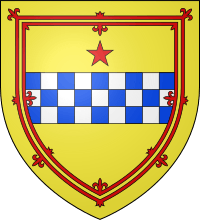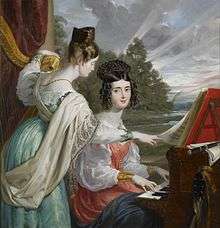Charles Stuart, 1st Baron Stuart de Rothesay
Charles Stuart, 1st Baron Stuart de Rothesay GCB PC (2 January 1779 – 6 November 1845), known as Sir Charles Stuart between 1812 and 1828, was a British diplomat. He was twice Ambassador to France and also served as Ambassador to Russia between 1841 and 1844.
The Lord Stuart de Rothesay GCB PC | |
|---|---|
 | |
| British Ambassador to Russia | |
| In office 1841–1844 | |
| Preceded by | The Marquess of Clanricarde |
| Succeeded by | Hon. John Bloomfield |
| British Ambassador to France | |
| In office 1828–1830 | |
| Preceded by | The Viscount Granville |
| Succeeded by | The Viscount Granville |
| British Ambassador to France | |
| In office 1815–1824 | |
| Preceded by | The Duke of Wellington |
| Succeeded by | The Viscount Granville |
| Personal details | |
| Born | 2 January 1779 |
| Died | 6 November 1845 (aged 66) Highcliffe Castle, Dorset, England |
| Nationality | British |
| Spouse(s) | Lady Elizabeth Margaret Yorke |
| Relations | Sir Charles Stuart (father) John Stuart, 3rd Earl of Bute (grandfather) |
| Alma mater | Christ Church, Oxford |
| Occupation | Diplomat |

Background and education
Stuart was the son of the Lieutenant-General The Honourable Sir Charles Crichton-Stuart, younger son of Prime-Minister John Stuart, 3rd Earl of Bute. His mother was Louisa Bertie, daughter of Lord Vere Bertie, younger son of Robert Bertie, 1st Duke of Ancaster and Kesteven. He was educated at Eton and Christ Church, Oxford.[1]
Diplomatic career
Stuart joined the Diplomatic Service in 1801, and was immediately appointed as Secretary of Legation in Vienna, Holy Roman Empire, a post he held until 1804. He was then sent to Petersburg and this was followed by an assignment in French occupied Spain in 1808.[2] He served as Envoy Extraordinary and Minister Plenipotentiary to Portugal and Brazil between 1810 and 1814.
He was appointed a Knight of the Most Honourable Order of the Bath (KB) in 1812[3] and sworn of the Privy Council in 1814.[4]
Briefly Ambassador to the Netherlands between February and May 1815, it was during his posting as Ambassador in Spain that he became indispensable to the Duke of Wellington. At the Generals' insistence, he was appointed British Ambassador to France. During Napoleon's Hundred Days, he left Paris and was in Brussels at the start of the Waterloo Campaign, where during his stay he attended the Duchess of Richmond's Ball.[5] After the fall of Napoleon, he escorted the exiled French King Louis XVIII back to Paris, and became British Ambassador there until 1824. In 1815 he was made a Knight-Grand-Cross in the civil division of the Most Honourable Order of the Bath (GCB).[6]
From 1825 to 1826 he was once more Envoy Extraordinary and Minister Plenipotentiary to Portugal and Brazil. In 1825 the Portuguese King John VI named Stuart his plenipotentiary with powers to negotiate and sign with Brazil a Treaty on the recognition of that country's independence. Invested with those powers, Stuart signed the treaty recognising Brazilian independence on 29 August 1825, and on 15 November of the same year the Portuguese King ratified the treaty. He was then created 1st Count of o Machico by Decree of 22 November 1825 by John VI of Portugal and later 1st Marquess of Angra by Decree of 1 May 1826 by Maria II of Portugal, then still in Brazil, and was created the 5th Grand-Cross of the Portuguese Ancient and Very Noble Order of the Tower and Sword, of the Valour, Loyalty and Merit.[1]
In January 1828 he was once again appointed Ambassador to France and was raised to the Peerage of Great Britain and Ireland as Baron Stuart de Rothesay, of the Isle of Bute, at the same time.[7] He continued as Ambassador to France until November 1830.[8] In 1841 he was made Ambassador to Russia, a post he held until 1844.[1]
Personal life

Lord Stuart de Rothesay married Lady Elizabeth Margaret, daughter of Philip Yorke, 3rd Earl of Hardwicke, on 6 February 1816. They had two daughters:
- Hon. Charlotte Stuart (1817–1861), wife of Charles Canning, 1st Earl Canning.
- Hon. Louisa Anne Stuart (1818–1891), wife of Henry Beresford, 3rd Marquess of Waterford.
Highcliffe Castle
Early retirement from the diplomatic service meant he start on a project to build a new family home. By 1830 he had purchased much of the eastern end of the estate, at Highcliffe, Dorset. Previously had been owned by his forebears, the estate had been sold by his father.[9] He engaged William Donthorne, a founder member of the Royal Institute of British Architects, to design a new Highcliffe Castle. The castle is built on an L shaped plan, oriented on a south-east axis, so the oriel window is central on the south east elevation, providing a vista across the landscaped gardens to a panorama of the needles and Isle of Wight. Used in the building of the house was carved medieval stonework from the Norman Benedictine Abbey of St Peter at Jumieges and from the Grande Maison des Les Andelys. Both of these buildings had fallen into disrepair after the French Revolution. Also included in the castle, were a 16th-century oriel window and a stained glass window.

Later life
After the Castle was completed, Charles became Ambassador to Russia in 1841. However ill-health caused his return to England and he died at Highcliffe in November 1845, aged 66, when the barony became extinct. He was buried at St Mark's Church, Highcliffe and his memorial can still be seen there. Lady Stuart de Rothesay remained a widow until her death in June 1867.[1]
References
- thepeerage.com Charles Stuart, 1st and last Baron Stuart de Rothesay
- Online Archive of California "Charles Stuart de Rothesay" Online reference http://www.oac.cdlib.org/findaid/ark:/13030/tf3p300592
- "No. 16650". The London Gazette. 26 September 1812. p. 1966.
- "No. 16938". The London Gazette. 24 September 1814. p. 1913.
- (De Ros 2005)
- "No. 16972". The London Gazette. 4 January 1815. p. 18.
- "No. 18433". The London Gazette. 18 January 1828. p. 122.
- "No. 18755". The London Gazette. 10 December 1830. p. 2579.
- Highcliffe Castle staff 2012.
References
| Wikimedia Commons has media related to Charles Stuart, 1st Baron Stuart de Rothesay. |
- De Ros, Georgiana, Dowager Lady (July 2005), "Complimentary Issue", The Regency Library External link in
|title=, |journal=(help);|chapter=ignored (help) (Originally published in Murray's Magazine Part I., 5, 1889, pp. +and+did+not+do+the+honours+of+the+ball+well&dq=, +and+did+not+do+the+honours+of+the+ball+well&pgis=1 40–43 - Highcliffe Castle staff (17 June 2012), Lord Stuart de Rothesay, Highcliffe Castle, archived from the original on 16 January 2014, retrieved August 2012 Check date values in:
|accessdate=(help) - Oliver; Boyd, New Edinburgh Almanack for the year
| Diplomatic posts | ||
|---|---|---|
| Preceded by Hon. John Villiers |
Envoy Extraordinary and Minister Plenipotentiary to Portugal and Brazil 1810–1814 |
Succeeded by Thomas Sydenham |
| Preceded by The Duke of Wellington |
British Ambassador to France 1815–1824 |
Succeeded by The Viscount Granville |
| Preceded by The Viscount Granville |
British Ambassador to France 1828–1830 |
Succeeded by The Viscount Granville |
| Preceded by The Marquess of Clanricarde |
British Ambassador to Russia 1841–1844 |
Succeeded by Hon. John Bloomfield |
| Peerage of the United Kingdom | ||
| New creation | Baron Stuart de Rothesay 1828–1845 |
Extinct |